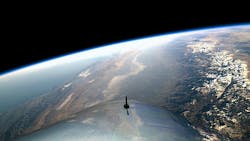Virgin Galactic successful in sending humans to FAA definition of space for the first time
Virgin's Richard Branson said after a successful touchdown, “Many of you will know how important the dream of space travel is to me personally. Ever since I watched the moon landings as a child I have looked up to the skies with wonder. We started Virgin nearly 50 years ago dreaming big and loving a challenge. Today, as I stood among a truly remarkable group of people with our eyes on the stars, we saw our biggest dream and our toughest challenge to date fulfilled. It was an indescribable feeling: joy, relief, exhilaration and anticipation for what is yet to come."
He continued, "Today, for the first time in history, a crewed spaceship, built to carry private passengers, reached space. Today we completed our first revenue generating flight and our pilots earned their Commercial Astronaut Wings. Today, we have shown that Virgin Galactic really can open space to change the world for good. We will now push on with the remaining portion of our flight test program, which will see the rocket motor burn for longer and VSS Unity fly still faster and higher towards giving thousands of private astronauts an experience which provides a new, planetary perspective to our relationship with the Earth and the cosmos. This is a momentous day and I could not be more proud of our teams who together have opened a new chapter of space exploration.”
George Whitesides, CEO of Virgin Galactic and The Spaceship Company, said: “What we witnessed today is more compelling evidence that commercial space is set to become one of the twenty-first century’s defining industries. Reusable vehicles built and operated by private companies are about to transform our business and personal lives in ways which are as yet hard to imagine. New enterprises are being created which will become hugely valuable, while enabling humanity to better manage some of its greatest future challenges. Today was a remarkable achievement brought about by the skill, dedication and support of our shareholders, staff, customers, partners and many other stakeholders. We extend our congratulations and thanks to each and every one of them.”
Related: Virgin Galactic aims to reach space soon with tourism rocket
The flight also included four NASA-supported technology payloads onboard. “We want to see how dust in microgravity behaves when it’s disturbed. How fast will it fly around? How careful do you have to be to avoid disturbing the surface too much? If you have a hard landing and disturb the surface a lot, how long will you have to wait for the dust to clear?” Principal Investigator Josh Colwell at the University of Central Florida said of one experiment conducted on the maiden space flight.
Other experiments included biological imagine in suborbiatl applications, a microgravity multi-phase flow experiment, and testing a vibration isolation platform.
“The anticipated addition of SpaceShipTwo to a growing list of commercial vehicles supporting suborbital research is exciting,” said Ryan Dibley, Flight Opportunities campaign manager at NASA’s Armstrong Flight Research Center in Edwards, California. “Inexpensive access to suborbital space greatly benefits the technology research and broader spaceflight communities.”
Ready to make a purchase? Search the Intelligent Aerospace Buyer's Guide for companies, new products, press releases, and videos
About the Author
Jamie Whitney
Senior Editor
Jamie Whitney joined the staff of Military & Aerospace Electronics in 2018 and oversees editorial content and produces news and features for Military & Aerospace Electronics, attends industry events, produces Webcasts, and oversees print production of Military & Aerospace Electronics.
